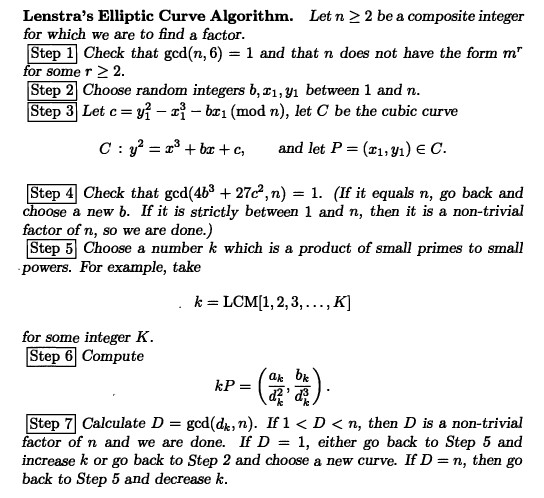In the realm of cryptography, where complex concepts intertwine with mathematical elegance, one algorithm stands as a notable beacon: Lenstra’s Elliptic Curve Factorization. Developed by Hendrik Lenstra in the late 1980s, this innovative technique has captivated mathematicians and cryptographers alike, owing to its ability to factor large integers efficiently. Its underlying principles unveil a deeper intricacy in number theory and lend to a greater understanding of elliptic curves—a subject often shrouded in enigmatic allure.
To grasp the significance of Lenstra’s approach, it is paramount to appreciate the historical context of integer factorization. Before the advent of elliptic curve methods, classical algorithms reigned supreme. Techniques like trial division and the Quadratic Sieve provided limited success, especially as the numbers grew in size. Recognizing the computational difficulty associated with factorization, the cryptographic community began to seek more potent methodologies. Enter the elliptic curve.
Elliptic curves are not merely abstract algebraic constructs; they possess a geometric representation that embodies many intriguing properties. Defined by a simple equation in the form y² = x³ + ax + b, these curves exhibit unique behavior under addition, leading to the formation of a group structure. This group structure subtly intertwines with number theory, unlocking a treasure trove of applications, one of which is factorization.
Lenstra’s method, formally known as Lenstra Elliptic Curve Factorization (ECF), leverages the mathematical properties of these curves to facilitate the factorization of composite numbers. The process begins with selecting a random elliptic curve and a point on that curve. Subsequently, it employs the group law to derive a series of points, calculating their respective coordinates mod n, where n is the integer to be factored. This seemingly innocuous process leads to the revelation of nontrivial factors with surprising regularity.
A hallmark of the Lenstra approach is its extensive reliance on the theory of the number field. By connecting the elliptic curve method to the structure of the integers, it provides an efficient pathway to identify common divisors. Through the iterative calculations that ensue, the algorithm takes advantage of properties such as the “order” of the elliptic curve, which relates to the number of rational points on the curve over a specified field. This nuance starkly contrasts traditional methods, showcasing the algorithm’s superior efficiency—a fact that is not lost upon cryptographers.
The cryptographic implications of Lenstra’s algorithm are profound. In an era dominated by RSA and other public key schemes reliant on the hardness of integer factorization, the existence of a polynomial-time algorithm—though not strictly polynomial due to randomization—raises considerable concerns. The efficacy of Lenstra’s method hinges on the size of the factors and the randomness of the elliptic curve selected. A well-chosen curve can reveal factors in a matter of seconds or minutes, whereas traditional methods may languish for years.
One might ponder the underlying reasons for the fascination surrounding the Lenstra Elliptic Curve Factorization method. Beyond its practical applications in factorization, there exists an intrinsic beauty in the interplay between algebra and geometry that captivates mathematicians. The elegance of elliptic curves offers fertile ground for exploration; they serve not only as tools for factorization but also as conduits for deeper investigations into questions surrounding prime numbers, cryptographic security, and even the distribution of integer solutions to various equations.
Moreover, the algorithm’s adaptability highlights its potential in modern applications. While originally designed for integer factorization, the principles underlying ECF have inspired further research into cryptographic protocols. Concepts originating from Lenstra’s work have influenced the development of signature schemes, key exchange methods, and even advanced cryptosystems that exploit elliptic curves’ properties, such as Elliptic Curve Cryptography (ECC), which underpins modern secure communications.
Even so, the cryptographic community must tread carefully, as no algorithm is impervious. While Lenstra’s method is a marvel, it is essential to remain vigilant. The development of advancements in quantum computing poses existential threats to classical and contemporary cryptographic algorithms. Understanding the fundamental principles of elliptic curves can serve as an armor against potential vulnerabilities, encouraging innovations that withstand the test of time.
In conclusion, Lenstra Elliptic Curve Factorization stands as more than a mere algorithm; it embodies a crossroads of elegance, efficiency, and profound mathematical insight. The capability to factor integers with a finesse brought forth by the interplay of geometry and number theory reveals new horizons in cryptography. It invites further exploration and creates avenues for innovation. As the digital landscape continues to evolve, the Lenstra method will remain an integral part of both cryptographic history and future inquiries, inspiring a new generation of thinkers to unravel the enigmatic complexities of numbers.








Leave a Comment